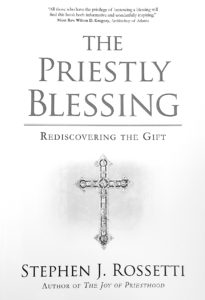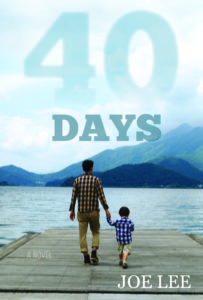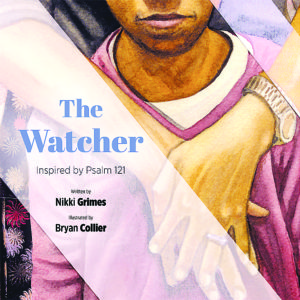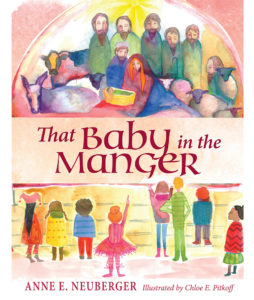 By James Tomek
By James Tomek
The following is a review of Stephen Rossetti’s The Priestly Blessing: Rediscovering the Gift (Notre Dame U: Ave Maria P, 2018). Sacraments are signs or events that are imbued with the presence of God. Rossetti substitutes sanctifying grace for God — the grace that allows us to transform material earthly presences into a more divine presence. Whenever we use any material resource like water and food for the benefit of humankind, we transform these resources into the body of Christ. Sacramentals are sacred signs that resemble the sacraments like blessings, crucifixes, rosary beads, and holy water. They are instituted by the Church rather than directly by Christ. They do not confer the grace of the Holy Spirit the way sacraments do. Stephen Rossetti’s book is a discussion of how blessings join into the nature of sacrament.
Father Rossetti’s elements of Blessings conform to Richard McBrien’s three essential elements of Catholicism: sacramentality, mediation and communion. Sacramentality sees all creation as sacred. Mediation adds that sacraments cause what they signify – like Mary, transforming worldly things into heavenly things. Communion sees us as Church being the sacrament of Jesus and, acting as a community, working together to achieve a heavenly communion of all saints, living, dead, and to come. (McBrien, Catholicism 9-13).
Father Rossetti defines priestly blessings as acts of singling out or consecrating persons, places, events, or things to a sacred or liturgical use. When we bless, we approve or God approves! Rossetti is talking mostly to priests, citing the greatest blessing when the priest imparts God’s consecration of the gifts of bread and wine at the Eucharist.
Stephen Rossetti begins with the use of blessings in the Old and New Testaments. In the Old Testament, blessing is a reciprocal action. We first bless or praise God. The berekah is the source of all blessings. Jesus continues this idea with the beatitudes, telling us what we should bless. Jesus lays hands on the food and on the apostles, giving them the power, in turn, to continue to set things aside for sacred use. Father Rossetti counsels us to be generous with blessings so we can evangelize or encourage others to pray.
A major theme of the former collection or book of blessings was exorcism, driving out evil (apotropaic) from things blessed. The newer book of blessings, revised at Vatican II, emphasizes that we bless the people using the objects blessed, de-emphasizing magical elements and encouraging more positive actions rather than just eliminating evil. Rossetti does not include the blessing of graves, but here is an important synthesis of where we not only bless the people, but also the ground where we all will be buried. The Church encourages us to be a community when receiving blessings stressing the liturgical prayer aspect.
Who can bless? Clergy vs Laity? As a lay ecclesial minister at Sacred Heart in Rosedale, how can I properly preside over the final blessing at our services in the absence of a priest? The priests “impart” blessings. The laity “invoke” them. While priests are more direct sacraments of Jesus in Holy Orders, imparting blessings directly, I feel no inferiority in that I have to ask God to bless us. Blessings are sacramentals. Are they “lower” than sacraments in imparting grace? Father Rossetti sees sacramentals as radiations of the sacraments with blessings standing in the fore front. I surely hope I can evolve to be a sacramental, clutching on to a grace from Jesus. Father Rossetti prays for “piety,” A BIG WORD. Joan of Arc says that we bless because Jesus did, and He commanded us to do his work. Piety’s root word goes back to compassion or sensitivity to those who are hurting (pity’s root meaning). When we feel piety for others we are close to blessing our neighbors. Saint Joan – Pray for us that we may feel this piety. Bless us Father for we have sinned.
Tag Archives: book review
Inspiration on ministry to those with disabilities

These are the covers of “Salt and Light: Church, Disability and the Blessing of Welcome for All” by Maureen Pratt and “A Cry Is Heard: My Path to Peace” by Jean Vanier with Francois-Xavier Maigre. The books are reviewed by Brian T. Olszewski. (CNS)
By Brian T. Olszewski (CNS)”Salt and Light: Church, Disability and the Blessing of Welcome for All” by Maureen Pratt. Twenty Third Publications (New London, Connecticut, 2018). 114 pp, $16.95.
“A Cry Is Heard: My Path to Peace” by Jean Vanier with Francois-Xavier Maigre. Twenty Third Publications (New London, Connecticut, 2018). 144 pp, $16.95.
One might be surprised that in a book of 114 pages, 16 of them are devoted to the introduction. Yet those are critical pages for Maureen Pratt’s “Salt and Light” as they explain why parishes need to examine how they welcome members with disabilities, how they minister to and with them, and how they invite them to minister within the faith community.
Pratt, a journalist who has lupus erythematosus, which she describes as “a chronic autoimmune condition that has no cure and can sometimes be life-threatening,” praises the church in general for its willingness to address the needs, particularly catechetical needs, of people with disabilities, and to make accommodations, e.g., ramps, elevators, enhanced listening devices, etc.
But she notes it is about more than that; the necessary ingredient in welcoming those with disabilities is “the right attitude.”
Pratt helps readers form that attitude through chapters that define disability; explain welcome and how it is to be extended; address catechetical formation; and delve into outreach, vocations, social life, etc. Each chapter begins with a question, e.g., “How do you welcome others into your life?” and concludes with “food for thought” and a prayer.
Those who serve parishes as ordained ministers, catechists, liturgical ministers, members of various councils and committees, and in any manner will benefit from “Salt and Light.” However, this is not a book for a shelf in the parish office.
Anyone familiar with Catholic outreach to those with developmental disabilities is aware of Jean Vanier, founder of L’Arche and co-founder of Faith and Light. In that awareness one knows of the call he accepted and the commitment he made to serve the other-abled. That commitment has inspired others throughout the world to do the same.
“A Cry Is Heard” is autobiographical, but in a manner and style one would expect from a 90-year-old faithful servant to the developmentally challenged who has something to say about people he’s met, experiences he’s had, and having a deep and loving relationship with God.
Readers will receive Vanier’s thoughts on St. Teresa of Kolkata, St. John Paul II, Dorothy Day and others whose names they might not recognize but who are important to the author. They’ll read about his experiences, e.g., L’Arche’s roots and growth, how it was received by the Pontifical Council for the Laity in the 1970s and the international impact the ministry has had.
(Olszewski is the editor of The Catholic Virginian, newspaper of the Diocese of Richmond, Virginia.)
Apologists outline helpful responses to criticisms of Catholic faith
By Brian Welter (CNS)
“Forty Reasons I Am a Catholic” by Peter Kreeft. Sophia Institute Press (Manchester, New Hampshire, 2018). 132 pp., $14.95.
“Forty Anti-Catholic Lies: A Myth-Busting Apologist Sets the Record Straight” by Gerard Verschuuren. Sophia Institute Press (Manchester, New Hampshire, 2018). 341 pp., $19.95.
Well-known philosopher and author Peter Kreeft and apologist Gerard Verschuuren both adopt simple yet at times challenging approaches to the truth of the faith. The short chapters and simple language make their books accessible to a variety of readers, from recent converts to those wanting to better present their beliefs to the perplexed.
As apologists, both authors directly address contemporary post-Christian culture and the frequent biases and accusations against the church. Yet they do so without maligning anti-Catholics. They thus model a powerful way to carry out St. John Paul II’s new evangelization.
Kreeft’s “Forty Reasons I Am a Catholic,” more personal than “Forty Anti-Catholic Lies,” given Kreeft’s reference to his own Catholic journey, addresses a wide range of issues, including secular society, infallibility, purgatory and Catholic community.
Though it surveys a wide range of topics, “40 Reasons I’m a Catholic” does address the essential issue of Scripture and tradition in some depth. The author argues convincingly that certain Protestant views of scriptural primacy are not only historically untrue but also illogical, concluding: “The church was both the efficient cause (the author) and the formal cause (the definer) of the New Testament.”
This historical fact leads to an even greater point: “No effect can be greater than its cause … and the infallible is greater than the fallible; therefore, the infallible cannot be caused by the fallible.” Thus, when Protestants claim that the church is fallible, they are undermining their own understanding of the Bible.
His confidence in the church never wavers. If the church’s claim about Jesus is wrong or untrue, “how to account for her wisdom, her holiness (her saints), her survival, and her fidelity to Christ’s teachings through 2,000 years of history?” This book adds a welcome dimension to Kreeft’s scholarly output.
Verschuuren’s wide-ranging “Forty Anti-Catholic Lies” presents a more scholarly and challenging argument. Despite the variety of topics covered, like Kreeft’s book, it never confuses or veers off topic. The chapters are assembled into seven broad themes including “Catholicism and the Bible” and “Catholicism and Science.”
The author addresses Protestant concerns more than those of non-Christians, such as pointing out the “biblical” nature of Catholic spirituality.
Other areas of contention addressed include historical events or realities often turned against the Catholic faith, including the Galileo affair, the Crusades, and the Inquisition. Regarding the latter, the author reminds readers of how attacks on the church often depend on erroneous argumentative techniques, such as the fallacy of judging the past by today’s standards: “What methods did the Inquisitors use? They basically used methods that civil courts would also use at the time.”
Verschuuren also addresses the exaggerated claims often made against the church: “Modern researchers have discovered that the Spanish Inquisition applied torture in 2 percent of its cases. Each instance of torture was limited to a maximum of 15 minutes. In only 1 percent of the cases was torture applied twice, and never for a third time.”
The author says the “gruesome lists of instruments of torture” that we have all heard of were post-Reformation fabrications.
Readers will come to see that many of our Christian brothers and sisters have abused the truth in a centuries-long anti-Catholic campaign. Perhaps “40 Anti-Catholic Lies” can therefore be seen as an attempt at a painfully necessary aspect of ecumenism, where Catholics need to address biased Protestant perspectives with robust correctives.
Some topics are fun to read, such as the chapter on apparitions. The prudent and even meticulous way ecclesiastical authorities deal with these reflects the church’s important protective function. The church prevents its members from getting caught up in harmful and even evil movements yet tolerates a wide range of practices, beliefs and communities. Apparitions can help Catholics “to enrich, deepen, or strengthen their faith.”
Perhaps surprising to some, the author observes that “the Catholic Church does not easily give in to what some consider a spiritual need of Catholics for ‘special’ visions, revelations, and apparitions.”
Both books would add greatly to the Catholic’s arsenal. The wide-ranging discussion of course comes at the price of in-depth discussion on any one topic, but the titles never promise anything but a survey. What they both do is whet readers’ appetites for greater in-depth discussion of widespread falsehoods regarding the church and its teachings.
(Welter has degrees in history and theology and teaches English in Taiwan.)
Comic book story of baseball
By Mark Judge (CNS)
NEW YORK – ” Baseball and comic books, two colorful American originals, come together in “The Comic Book Story of Baseball: The Heroes, Hustlers, and History-Making Swings (and Misses) of America’s N ational Pastime” (Ten Speed Press) by author Alex Irvine and illustrators Tomm Coker and C.P. Smith.
ational Pastime” (Ten Speed Press) by author Alex Irvine and illustrators Tomm Coker and C.P. Smith.
This factually jam-packed and beautifully designed book is suitable for most older teens and adults. Still, parents should be cautioned: Baseball is a sport that has always included rough and crude language, a couple of instances of which are reproduced here (censored with asterisks).
There also are references to the drug use that occurred during the “steroid era” of the game in the 1990s.
The art is done in a beautiful realist style featuring artistic renderings based on reproductions of historical photographs. The basics are all here: Abner Doubleday, who supposedly invented the game in 1839 (this has been debunked as mostly myth); Babe Ruth, Ty Cobb, Cy Young, and superhuman Hall of Fame pitcher Walter Johnson.
There’s the “Murderer’s Row” 1927 New York Yankees; and Joe DiMaggio, Bob Gibson and Sandy Koufax.
More recent greats take the field as well, including (and this is a very small sampling) Lou Brock, Hank Aaron, Rickey Henderson, Greg Maddux, Roger Clemens, flipping shortstop Ozzie Smith, dazzling relief pitcher Mariano Rivera and Red Sox slugger David Ortiz. The great ballparks, like Wrigley and Fenway, are celebrated, and there’s a section on Japanese baseball.
Yet Irvine and his collaborators also cover the scandals and the more obscure history and factoids of the game. There’s the infamous 1919 “Black Sox” scandal of a World Series thrown for money, and the disgrace of black ballplayers being forced to play in the Negro Leagues until the Brooklyn Dodgers’ Jackie Robinson reintegrated the game in 1947.
In 1970, pitcher Jim Bouton published a juicy memoir, “Ball Four,” that exposed the drug use and other excesses of several players. As Irvine notes, Bouton “blew the lid off baseball’s long-held tradition of clubhouse omerta.”
There was also the modern steroid period, during which home run tallies where inflated due to performance-enhancing drugs.
On the lighter side, Irvine, Coker and Smith (names that sounds like double-play combination) reveal the quirkiness that has always been part of baseball. The Yankees were the first team to put number on their uniforms in 1929, so that fans in the “cheap seats” could identify their favorite players. There’s William Arthur “Candy” Cummings, who invented the curveball in 1867 based on how tossed clamshells flew in an arc.
Also here is Charley Pride, the Negro League player who became a country music star and now owns part of the Texas Rangers. Of course, no baseball book would be complete without Berraisms, those pithy quips from famous Yankees catcher Yogi Berra.
“Ninety percent of baseball is mental,” Berra said. “The other half is physical.” Berra was on 10 World Series teams, more than any other player.
In sum, the book amounts to a well-pitched delight.
The graphic book contains two partially censored vulgar expressions. The Catholic News Service classification is A-II – adults and adolescents. Not otherwise rated.
(Judge reviews video games and comic books for Catholic News Service.)
40 Days uses Lenten season to support suspense
Book review:
By Donna Biggert
With his latest novel 40 Days, Joe Lee has created another page-turner set in the fictitious Mississippi town of Oakdale. The story begins with the protagonist, Duane Key, starting to realize he must make some drastic changes to set right the results of a life of bad decisions. Joe writes him with an all-too-believable list of screwed-up relationships, but gives him true-to-life redeeming characteristics while he surrounds him with a faithful lifelong friend, a sincerely loving girlfriend, and a precious six year old son.

Additional characters like Duane’s self-centered egotistic career-minded wife Toni, his crazy ex-girlfriend and Oakdale’s librarian, Candi Redding, as well as the individuals they each interact with, also display an overabundance of mixed-up personalities indicative of real life. As with his other seven novels, Lee develops his characters to the extent that you feel you know them. With his meticulous descriptions and every-day life details, he makes Oakdale seem like many a small Mississippi town, with colorful and off-color citizens, nosy neighbors and a laid-back pace.
The faith-based element of this story makes it a little different from Lee’s previous novels. With references to the Catholic Church, a tremendously understanding priest, and the Lenten Season, this book is a good representation of a lay Catholic’s grasp of God’s love. Particular descriptions about Duane’s baptism, the church, and God’s love and forgiveness are comforting reading for a believer. The entire story is built around an almost unbelievable numerical countdown that Duane experiences which only he can see. Lee even numbers the chapters in descending order to accentuate the countdown of forty days, emphasizing that time is running out. As the suspense builds with the countdown, so does the sense of urgency for making amends for past misdeeds.
The all-too-lifelike unpredictability of troubled individuals is played out in several scenarios. Virtues like hope and charity as well as the determination to correct past misdeeds are demonstrated all through the story.
As Duane, the protagonist, deliberately and methodically sets about making many big and positive changes in his life, the writer uses the countdown to underscore the sense of urgency Duane feels. True remorse, forgiveness, and redemption are threaded throughout the pages.
40 Days, like Joe Lee’s other novels, is an easy and entertaining read. The characters are at once familiar and believable and while they don’t necessarily behave in a moral way, the reader is left with insight into the rightness of making amends while there is time.
(Donna Biggert is a parishioner of Madison St. Francis of Assisi. Joe Lee is a Madison author and publisher.)
Children’s books show Christmas’ true joy with beautiful stories, art
By Regina Lordan
NEW YORK (CNS) – The following books are suitable for Christmas giving:
“The Watcher” by Nikki Grimes, illustrated by Bryan Collier. Eerdmans Books for Young Readers (Grand Rapids, Michigan, 2017). 42 pp., $17.
“The Watcher” is a rare treasure in the world of children’s books: The verse is poetic, the illustrations are a compelling blend of photographs and drawings, and the story is a gripping tale of bully and victim … or is it? The narration unfolds and reveals that the instigator is really just a lonely child desperate for a friend. Influenced by Psalm 121, which attributes all help to God’s loving protection and care, it is written in “golden shovel” form, in which the last word of each verse is a word from the psalm. “The Watcher” is a story that holds onto you as it slowly reveals understanding, compassion and innocent faith in God’s love and protection. After it is read, its lyrical tale will not be soon forgotten. Ages 6-10.

These children’s books are suitable for Christmas giving: “The Watcher” by Nikki Grimes, “That Baby in the Manger” by Anne E. Neuberger and “The Secret of the Santa Box” by Christopher Fenoglio. The books are reviewed by Regina Lordan. (CNS).
“Be Yourself: A Journal for Catholic Girls” by Amy Brooks. Gracewatch Media (Winona, Minnesota, 2017) 100 pp., $20.
“Be Yourself” is a place for Catholic girls and young women to indeed learn how to be themselves, just the way God intended them to be. Colorful, interactive and brimming with saint spotlights, prayers and biblical quotes, “Be Yourself” will encourage Catholic girls to, as author Amy Brooks writes, nourish their relationship with God to better know his will for them and to use the journal to “navigate that relationship – on good days and bad days.” Ages 9 and up.
“Look! A Child’s Guide to Advent and Christmas” by Laura Alary, illustrated by Ann Boyajian. Paraclete Press (Brewster, Massachusetts, 2017) 32 pp., $16.99.
Advent is a time of anticipation and waiting, but it can also be a time for reflection and mindfulness of today … if we take the time to look. Author Laura Alary welcomes children to be aware, appreciate and change during Advent within a biblical and present-day context. She tells the story of Jesus’ birth within the framework of children’s daily lives, and she encourages children to anticipate Christmas by preparing to say “yes” to God with simple, practical activities and works of service. Ages 5-10.
“Anointed: Gifts of the Holy Spirit” by Pope Francis. Pauline Books and Media (Boston, 2017) 120 pp., $18.95.
Intended for young men and women preparing to receive the gifts of the Holy Spirit in the sacrament of confirmation, but appropriate for all teens, “Anointed” is a compilation of the teachings of Pope Francis brightly illustrated with graphics and photos, Bible verses and prayers. “Anointed” makes the pope’s teachings accessible and engaging, and invites readers to openly receive the gifts that God has given us. Ages 12-18.
“That Baby in the Manger” by Anne E. Neuberger, illustrated by Chloe E. Pitkoff. Paraclete Press (Brewster, Massachusetts, 2017) 31 pp., $15.99.
Father Prak was puzzled: A group of curious children, beautiful in their multicultural diversity, were preparing for Christmas Mass when they started asking questions about the statue of the baby Jesus. Why didn’t he look like many of them, and why didn’t he look like Jesus most likely did, with dark skin, hair and eyes? The priest turned to God for help while an innocent parishioner in the church overheard the discussion. Answering Father Prak’s prayers through the eavesdropper’s clever idea, the children discovered that through the gift of Christmas, Jesus has come to save each and every one of them, no matter what they look like. A perfect Christmas gift for children, this book celebrates the truth of Christmas while highlighting the mystery of God’s interactions with us through prayer and each other. Ages 4-10.

These children’s books are suitable for Christmas giving: “The Watcher” by Nikki Grimes, “That Baby in the Manger” by Anne E. Neuberger and “The Secret of the Santa Box” by Christopher Fenoglio. The books are reviewed by Regina Lordan. (CNS)
“Angel Stories from the Bible” by Charlotte Grossetete, illustrated by Madeleine Brunelet, Sibylle Delacroix and Eric Puybaret. Magnificat (New York, 2017) 47 pp., $15.99.
Beginning with Jacob’s ladder and ending with the angel appearing at Jesus’ tomb, author Charlotte Grossetete adapts biblical passages of God’s celestial messengers into children’s short stories. Children will enjoy the illustrations of the five stories, created by three artists with varying styles, and the narratives of God intervening in human lives with his angels out of love and care. Particularly appropriate for Christmas, “Angels Stories from the Bible” includes St. Gabriel the Archangel visiting Mary to announce Jesus’ impending arrival. Ages 5 and up.
“The Secret of the Santa Box” by Christopher Fenoglio, illustrated by Elena K. Makansi. Treehouse Publishing Group (St. Louis, 2017). 32 pp., $16.95.
There comes a time in every parent’s life when a child anxiously asks them, “Is Santa real?” Many parents struggle with this answer, knowing that with the loss of belief in the jolly old man comes the loss of a part of childhood. But fear not, the Catholic faith shows us that the real joy of Christmas is Jesus’ birth itself and the joy of the mystery of Christmas comes not from Santa but from everyone but Jesus himself. “The Secret of the Santa Box” is a needed book for curious children ready to move past the secular stories of Christmas and into a deeper relationship with the true meaning of Christmas. It gently explains the sometimes sensitive topic in cheerful and thoughtful rhymes and illustrations. Ages 7-10.

These children’s books are suitable for Christmas giving: “The Watcher” by Nikki Grimes, “That Baby in the Manger” by Anne E. Neuberger and “The Secret of the Santa Box” by Christopher Fenoglio. The books are reviewed by Regina Lordan.
araclete Press (Brewster, Mass., 2017) 64 pp., $11.99
Ever find yourself at a loss of words when trying to pray? Sometimes the actual effort to find the right thing to say is so distracting that prayer is lost in frustration. Author Sybil MacBeth found her words trivial and trite compared to the magnitude of her prayer intentions, so she created a doodle book to encourage focus, creativity and a space to pray. Guided by a relaxed formula, older children can practice this version of “lectio divina.” “Pray for Others in Color” and “Count Your Blessings in Color,” also by Sybil MacBeth, offer similar avenues for intercessory prayers and prayers of gratitude. Ages 12-18.“Molly McBride and the Plaid Jumper” by Jean Schoonover-Egolf. Gracewatch Media (Winona, Minnesota, 2017) 32 pp., $11.
One in a series, “Molly McBride” helps normalize discussions about religious vocations through its cheerful and accessible narratives about a young girl and her women religious friends. Molly wants to be one of the “Purple Nuns,” and she wears her purple habit everywhere. But she will be attending Catholic school soon and will have to wear a school uniform. Thankfully, a fun-loving priest and her parents help Molly understand that Jesus’ love is much deeper than the clothes she wears. Children will love Molly and her cute wolf pet named Francis. Ages 4-8.
(Lordan, a mother of three, has master’s degrees in education and political science and is a former assistant international editor of Catholic News Service.)
Late exorcists words lift the veil on the demonic, Satan
By Allan F. Wright
“An Exorcist Explains the Demonic: The Antics of Satan and His Army of Fallen Angels” by Father Gabriele Amorth with Stefano Stimamiglio. Sophia Institute Press (Manchester, New Hampshire, 2016). 145 pp., $14.95.
The world-renowned exorcist, Pauline Father Gabriele Amorth has left his wisdom and experience in dealing with evil forces through this insightful compendium gleaned from interviews published in Credere magazine over the past few years.
Father Amorth founded the International Association of Exorcists and performed thousands of exorcisms in his life. He is refreshingly direct throughout the book and doesn’t mince words when it comes to the reality of the demonic, evil spirits and Satan.
His writing conveys a sense of comfort and hope for those suffering from physical and spiritual ailments such as vexation, obsession and infestation, all believed to stem from demonic forces.
Father Amorth attributes the rise on demonic activity to the decline in faith in God. “When faith in God declines, idolatry and irrationality increase; man must then look elsewhere for answers to his meaningful questions.” The principle of total and complete liberty apart from God and the denial of truth itself are indeed seductive in appearance but ultimately fail to satisfy the “desires of the human heart.”
Young people in particular, “are easily deluded and are attracted to these ‘seductions’ which has been the desire of Satan since the beginning.” Extreme danger arises when these demonic spirits are invited into a person’s life. Amorth goes into detail on specific cases he has encountered.
While we are all victims of temptations, not everyone is a victim of what he calls an “extraordinary action of Satan.” Nor are extraordinary actions of Satan or evil spirits the fault of those who are victim of these attacks.
However, there are an incredible amount of people who declare their allegiance to Satan, the “father of lies.” The casting of spells and “infestations of the demonic” are in fact a reality and chronicled in this book.
In chapter three, “The Cult of Satan and Its Manifestations,” topics such as spirtism, occultism, fortunetellers, piercings, tattoos and satanic music are addressed.
He states that the three rules of Satanism are: “You may do all you wish, no one has the right to command you, and you are the god of yourself.” One doesn’t need to be exposed to a satanic heavy metal band to see those three elements alive and operating in our culture.
Although “An Exorcist Explains the Demonic” is profoundly disquieting, Father Amorth reminds readers of God’s victory over Satan and the tools for growing in holiness and fighting evil provided by the church in the sacraments, sacramentals and prayer. God loves us as a father and desires to protect us.
The reader may be surprised by the amount of demonic activity that Father Amorth records in a matter-of-fact manner, yet always with the confidence that God is stronger. He recalls invoking with much success Mary, the mother of Jesus.
Father Amorth also was the exorcist for the Diocese of Rome during St. John Paul II’s pontificate so he has firsthand knowledge of at least three exorcisms that the pontiff performed in his private chapel. The demons are recorded as having a special indignation when his memory is invoked because St. John Paul “ruined their plans.” Father Amorth believes the reason for this is linked to Fatima and to the consecration of the world to the Immaculate Heart of Mary by St. John Paul March 25, 1984.
The book also relies on Scripture and the Catechism for insights into heaven, hell, purgatory and the rite of exorcism itself. Father Amorth makes a solid case for the need for many more exorcists and even suggests that every seminarian be exposed to the work of exorcism as an essential course of study. This compendium is a suitable witness to both the man and his struggle with evil.
(Wright is an author and academic dean of evangelization for the Diocese of Paterson and resides in New Jersey.)
